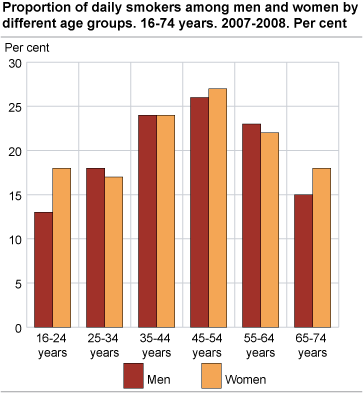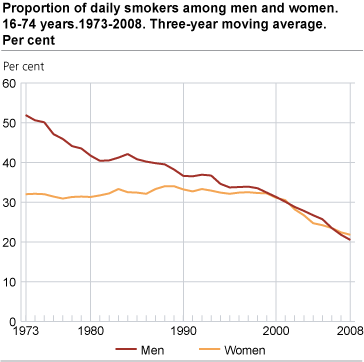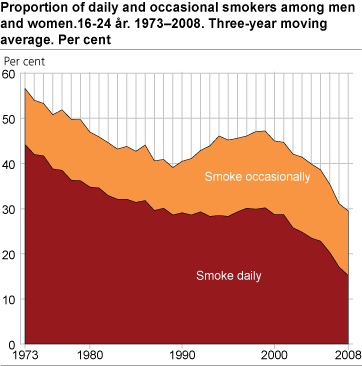Content
Published:
This is an archived release.
Steady decline in number of daily smokers
A total of 21 per cent of all 16-74 year-olds smoked daily in 2008; one percentage point less than in 2007. This figure has fallen steadily over the past 10 years, and there are fewer smokers nowadays particularly among the young.
Statistics Norway conducts annual surveys on smoking prevalence. The 2008 surveys show that 21 per cent of the population aged 16-74 smoke on a daily basis, compared with 22 per cent in 2007. In addition, approximately 9 per cent smoked occasionally in 2008, one percentage point less than the previous year.
The proportion of daily smokers in 2008 is 21 per cent for both men and women, compared with 23 per cent for women and 21 per cent for men in 2007. Nine per cent of women and 10 per cent of men smoked occasionally in 2008.
The largest share of daily smokers is found in the age group 35-64 years, while the smallest share is reported by the youngest and the oldest age groups.
Decrease since 1998
In 1973, more than half of the adult male population smoked, compared with around 21 per cent today. From 1973 to 2000, the share of women who smoked every day was slightly higher than 30 per cent, but this figure has also fallen considerably and is now 21 per cent, the same as for men. A shift in smoking prevalence appears to have taken place around 1998. Since then, smoking prevalence has declined at about the same rate for men and women.
Significant decline in smoking among 16-24 year-olds
In 2008, about 15 per cent of young people aged 16-24 said that they smoked on a daily basis, and around 13 per cent reported smoking occasionally. In 2007, 16 per cent reported to smoke daily in this age group, but the decline is not significant (with a 95 per cent confidence interval). However, the change is significant from 2005 to 2008, with a fall from 24 to 15 per cent. The sample is relatively small and is therefore best suited to studying long-term trends rather than annual changes.
The number of young people who start smoking has fallen considerably since the 1970s. The major decline in smoking prevalence observed to the end of the 1980s did not apply to some years and was followed by a marked increase in occasional smokers in the first half of the 1990s. However, the development now seems to be moving in a positive direction, and the total share of young people who smoke is clearly falling.
About the surveysStatistics Norway has conducted surveys on smoking prevalence since 1973. The share of smokers is measured by two questions: "Do you sometimes smoke?" and "Do you smoke daily or occasionally?" In the course of a year, four surveys with a total sample of 5 000 are carried out. There are possible sources of error in any interview survey. Additionally, in a sample as high as 5 000, error margins of more than one percentage point in either direction are used. To reduce the effect of random fluctuations in the data - particularly in presentations with a line diagram - a three-year moving average is normally applied. This is particularly important in periods where the sample has been smaller than it is today, and also when the results are broken down, by age group for example. In practice, a three-year moving average means that the average of the results for three consecutive years is calculated, and that this average represents the second year. The text table shows the outcomes of this. |
| Daily smokers 16-74 years | Daily smokers 16-24 years | ||||||||||||||||||||||||||||||||||||||
|---|---|---|---|---|---|---|---|---|---|---|---|---|---|---|---|---|---|---|---|---|---|---|---|---|---|---|---|---|---|---|---|---|---|---|---|---|---|---|---|
| Observed results |
Estimated three-year
moving average |
Sample size (N) | Observed results |
Estimated three-year
moving average |
Sample size (N) | ||||||||||||||||||||||||||||||||||
| 1998 | 33.0 | 32.9 | 5 088 | 31.2 | 29.9 | 797 | |||||||||||||||||||||||||||||||||
| 1999 | 32.0 | 32.3 | 4 913 | 27.7 | 30.2 | 783 | |||||||||||||||||||||||||||||||||
| 2000 | 31.9 | 31.2 | 5 004 | 31.5 | 28.7 | 806 | |||||||||||||||||||||||||||||||||
| 2001 | 29.8 | 30.3 | 5 047 | 26.8 | 28.7 | 781 | |||||||||||||||||||||||||||||||||
| 2002 | 29.4 | 28.5 | 5 311 | 27.8 | 25.8 | 819 | |||||||||||||||||||||||||||||||||
| 2003 | 26.3 | 27.3 | 5 094 | 22.8 | 24.8 | 812 | |||||||||||||||||||||||||||||||||
| 2004 | 26.0 | 25.8 | 5 034 | 23.7 | 23.5 | 852 | |||||||||||||||||||||||||||||||||
| 2005 | 25.0 | 25.0 | 5 029 | 24.1 | 22.8 | 833 | |||||||||||||||||||||||||||||||||
| 2006 | 23.9 | 23.6 | 4 756 | 20.3 | 20.3 | 763 | |||||||||||||||||||||||||||||||||
| 2007 | 21.7 | 22.1 | 4 813 | 15.5 | 17.1 | 682 | |||||||||||||||||||||||||||||||||
| 2008 | 20.7 | 121.2 | 4 486 | 14.9 | 115.2 | 650 | |||||||||||||||||||||||||||||||||
| 1 | Gjennomsnitt av 2007 og 2008. |
Contact
-
Elin Skretting Lunde
E-mail: elin.skretting.lunde@ssb.no
tel.: (+47) 92 42 70 07
-
Jorun Ramm
E-mail: jorun.ramm@ssb.no
tel.: (+47) 92 08 23 99
-
Arne Jensen
E-mail: arne.jensen@ssb.no
tel.: (+47) 99 71 22 45



